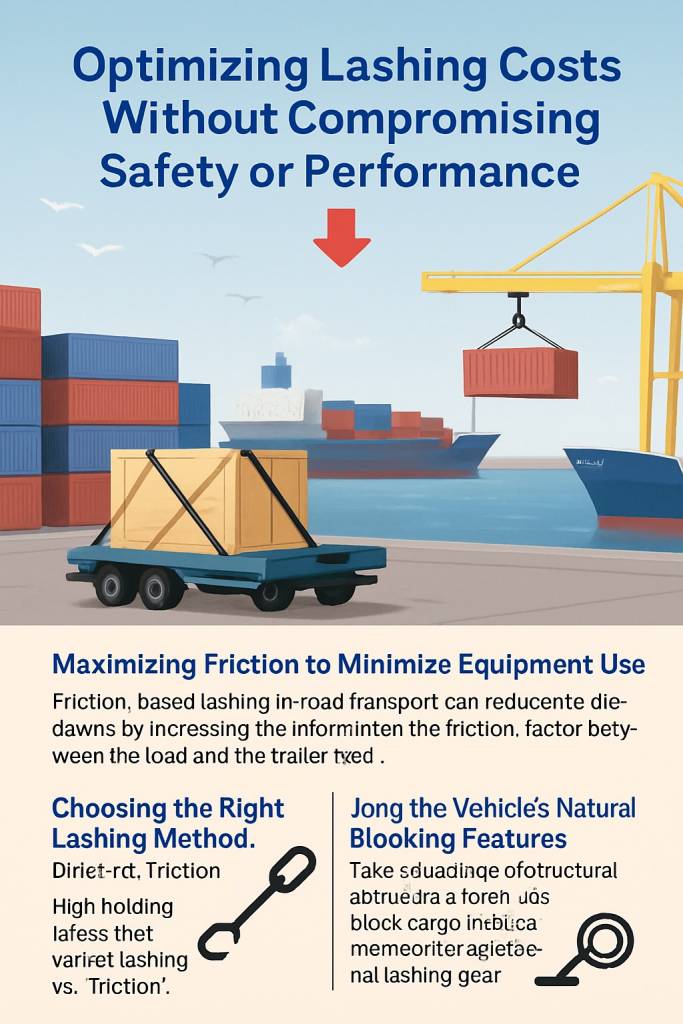Reducing the cost of load securing is a frequent challenge in transport logistics and freight operations, especially when companies see cargo lashing systems as excessively expensive.
This perception often leads to underinvestment in securing equipment and insufficient training, which paradoxically increases risks, delays, and total costs.
The good news: strategic technical decisions can significantly improve securing efficiency and reduce lashing costs—without compromising safety or compliance.
Can Cost Savings and High-Performance Cargo Securing Coexist?
Absolutely. The key lies in optimizing lashing techniques and using securing equipment effectively.
A better understanding of cargo securing principles helps make smarter decisions, avoid unnecessary expenditures, and ensure load safety.
4 Key Strategies to Reduce Lashing Costs in Freight Transport
1. Maximize Friction to Minimize Equipment Use
In top-over (friction) lashing—commonly used in road transport—increasing the friction coefficient between the load and the trailer bed can drastically reduce the number of tie-downs required.
Factors affecting friction-based lashing performance:
- Strap tensioning force (STF)
- Lashing angle
- Friction coefficient
- Even distribution of tension (e.g., gliding corners)
Example 1: A 10,000 kg wooden crate on a flatbed (wood-on-wood contact) with 80° lashing angles and STF 580 daN straps requires 18 straps to meet standard NF EN 12195-1.
Example 2: Adding anti-slip mats increases the friction coefficient to 0.6. The same load, under the same conditions, now only requires 4 straps—a reduction of more than 75%.
2. Choose the Right Lashing Method: Direct vs. Friction
The chosen cargo lashing method directly impacts both effectiveness and cost.
- Direct lashing can achieve much higher holding forces than friction lashing.
- For example, a direct strap in a head loop can generate over 4,000 daN of holding force—far more than friction-based setups.
Using the wrong lashing technique can lead to cargo damage, transport delays, and non-compliance.
3. Use the Vehicle’s Natural Blocking Features
A cost-effective load securing strategy is to take advantage of the vehicle’s built-in structural elements, such as container walls, bulkheads, or trailer ends, to block cargo.
Example: A mixed 10,000 kg load inside a container is poorly positioned, leaving gaps near the doors. Using wooden beams (750 daN) offers limited blocking capacity. But container doors can provide up to 11,200 daN—far superior to makeshift solutions.
4. Understand Lashing Points and Load Limits
The weakest component—strap, anchor point, or load attachment—determines the overall holding capacity.
- EN 12640: Vehicles over 12,000 kg gross weight must have lashing points rated at 2,000 daN minimum.
- Using chains rated for 6,000 daN is pointless if the anchor point can only support 2,000 daN.
Avoid overspecifying cargo securing equipment—it increases costs without adding performance.
Conclusion: Knowledge is the Best Cost Saver
Cost-effective cargo securing is not about cutting corners—it’s about informed decisions.
By understanding load restraint physics, choosing the right securing method, and leveraging vehicle infrastructure, companies can reduce lashing costs while ensuring safety and compliance.
Many transport companies miss these opportunities due to lack of cargo securing training.
Through load securing audits and tailored consultancy, it’s possible to achieve measurable savings while maintaining the highest safety standards.


